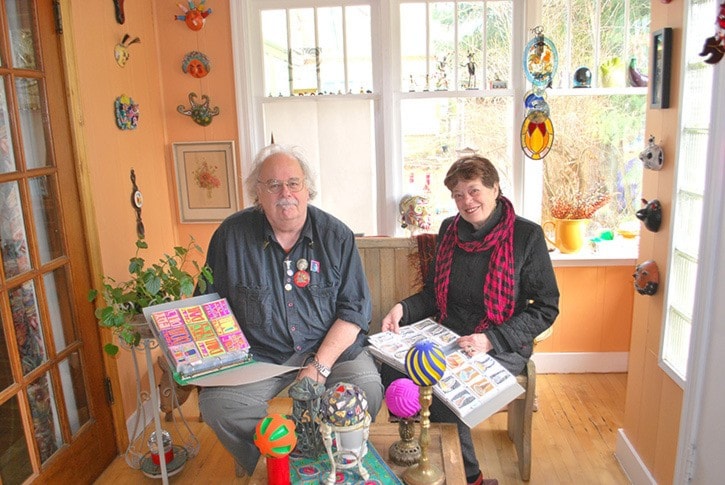It’s a gallery’s worth of art, all in a regular sized binder. When Wendy Toogood and Chuck Stake, whose everyday around town name is Don Mabie, head out to the monthly Artist Trading Card (ATC) session, they usually take at least nine new original artworks to trade with other local participants. And all nine fit in a single baseball or hockey card sleeve.
Good things come in small packages, and at the ATC sessions, they come in 2.5 x 3.5 inch (6.4 x 8.9 cm) dimensions. The size isn’t just for carting convenience, although being able to carry them about is part of the appeal. ATCs were developed by m. vänçi stirnemann, a fellow artist who worked with Stake in Calgary and began trading hockey cards while he was there in 1990.
The experience of sitting around trading cards while talking about life with other artists was so fun that vänçi decided he would like to document his time in the Albertan city in hockey card format. Unfortunately, due to the high costs associated with printing hockey-style cards, the project was shelved until 1996.
Renewed with a sense DIY-ness, vänçi decided to create the cards himself, and the first exhibition of 1,200 of his cards took place in April 1997. The reaction to the exhibit was so positive, that the artist decided to hold a trading card event as the closing of the show – cards couldn’t be bought, they could only be traded.
The first ATC session was so much fun, that vänçi decided to hold one every month, and Chuck Stake, who had seen the original exhibition, also took part in a subsequent session.
“I became very enthused with ATCs and brought the idea back to Calgary,” Stake said. The sessions caught on quickly, and artists and non-artists alike would congregate socially once a month and trade their most recent creative cards.
Stake points out that artists have used the card format for a number of purposes in the last few decades as promotional tools, catalogues and other commercial purposes.
ATCs, on the other hand, cannot be bought, must be traded, and can be handmade. ATC sessions are open to anyone, and the social part of the event is still key; both Stake and vänçi see the ATC process as a collaborative cultural performance.
The cards also do away with ideas of high and low art too, challenging traditional ideas of art and opening it up to be something that everyone can take part in.
“The creative freedom and spontaneity of artist trading cards also recalls the era of Dada,” said Stake, who also enjoys the fact that they don’t involve the exchange of money.
ATCs caught on in a big way, and there are now groups all over the world getting together every month to trade. In Calgary, the phenomenon caught like a prairie wildfire, with 40 to 50 traders attending regularly, and over a hundred showing up to trade cards at special events.
“Cards” may be a misleading term, though. The only real requirement is that they be of the size of a regular trading card, but in Stake and Toogood’s collection there have been cards that were ceramic, or transparent plastic holding some kind of specimen, or small books. A very small set of handbags made from paper with wire handles made up one set of cards, and even cookies had been made as another set at one point, Stake told the Arrow Lakes News.
What can be a card is completely up to the maker. Stake made a set of cards from a Neocitran box for one session when he was feeling under the weather, and to his surprise, there was interest in them. You never know what people will like.
Here in Nakusp, ATC sessions occur on the last Sunday of the month at the Broadway Deli from 1 to 2 p.m. So make up a set of cards (usually nine) and bring them down to trade and talk with the other ATCers.
